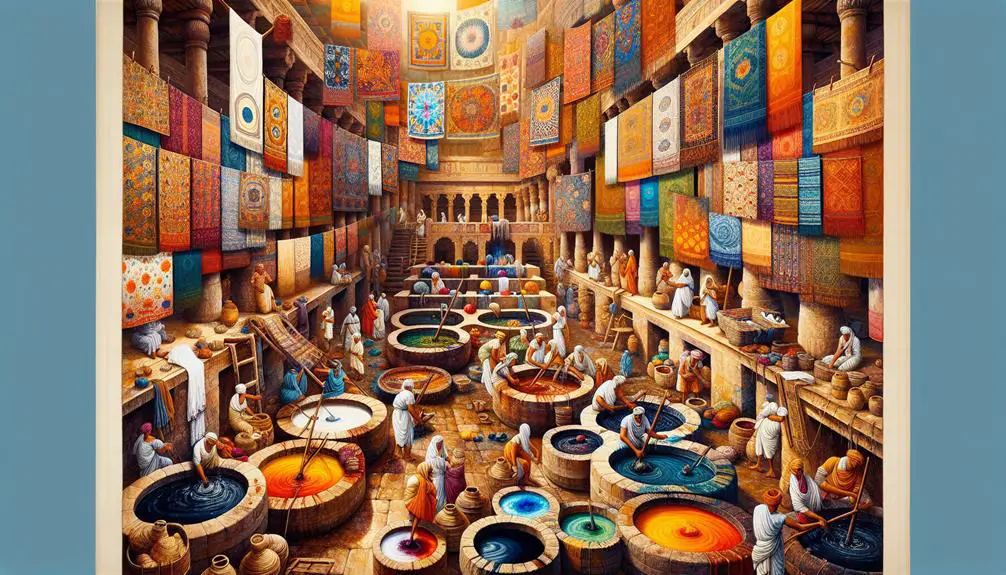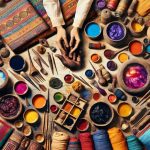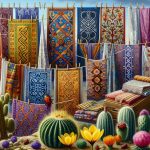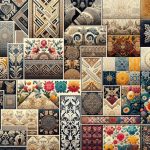Imagine a tapestry, each thread dyed with the essence of ancient wisdom and innovation. You're about to explore how early civilizations mastered the art of fabric dyeing with natural materials like plants, minerals, and even insects. These methods weren't just practical; they held deep cultural significance. Techniques like immersion and resist dyeing were pivotal in creating long-lasting, vibrant colors. As you trace this journey through medieval Europe and into the intricate practices of Asia, you'll find that the evolution of dyeing has led us to today's blend of tradition and modern sustainability. But have you ever wondered…
Table of Contents
Key Takeaways
- Ancient civilizations used natural dyes from plants, minerals, and insects for textile dyeing.
- Egyptians employed immersion and resist dyeing techniques like Batik to create intricate patterns.
- Medieval Europe used mordants like alum and iron to fix natural dyes and enhance color vibrancy.
- Asian traditions like Japanese Shibori and Chinese Indigo influenced modern textile dyeing methods.
- The mid-19th century saw the birth of synthetic dyes, revolutionizing the textile industry with consistent and vibrant colors.
Ancient Natural Dyes
Ancient civilizations used natural dyes derived from plants, minerals, and insects to color their textiles. You'll find it fascinating that these early societies mastered the art of extracting vibrant hues from the natural world.
Plant-based pigments were particularly significant. Madder root, for instance, produced rich reds, while indigo leaves yielded deep blues. These dyes weren't just about aesthetics; they held cultural, symbolic, and sometimes even spiritual significance.
To master ancient dyeing techniques, you need to understand the meticulous processes involved. Ancient artisans would often boil plant materials to extract the dye. This process required precision—too much heat or too little could ruin the color. Once the dye was ready, textiles were immersed and left to soak, allowing the fabric to absorb the pigments fully. Different mordants, like alum or iron, were used to fix the colors, enhancing their vibrancy and durability.
These ancient textiles weren't just functional; they were a tribute to human ingenuity and a deep understanding of natural resources.
Dyeing in Ancient Egypt
When you explore dyeing in Ancient Egypt, you'll find they used natural sources like plants and insects for their vibrant colors. They employed various methods such as boiling and fermentation to achieve long-lasting dyes.
Colors held significant cultural meanings, with each hue representing different aspects of life and status.
Natural Dye Sources
You'll find that dyeing practices in Ancient Egypt relied heavily on natural sources like plants, minerals, and insects. Egyptians mastered the art of using plant extracts for color extraction, which was essential for their vibrant textiles. They harnessed various plants to produce a range of colors, showcasing their deep understanding of nature's palette.
For a rich red hue, they often turned to madder root. This plant's roots were boiled to extract its dye, resulting in a striking, long-lasting color.
Indigo, another staple, provided that coveted deep blue. By fermenting the leaves of the indigo plant, they could create a dye that was both brilliant and enduring.
Minerals like ochre and malachite were also ground into fine powders to produce earthy tones, adding depth and variety to their fabric artistry.
- Madder Root: Extracted for rich reds.
- Indigo Leaves: Fermented for deep blues.
- Ochre and Malachite: Ground for earthy tones.
Dyeing Methods Employed
To achieve their vibrant textiles, Egyptians employed techniques like immersion dyeing and resist dyeing to guarantee even and long-lasting colors. By submerging fabrics in dye baths, you can confirm that every fiber absorbs the color uniformly. This method was particularly effective for achieving the rich hues that adorned Egyptian garments and linens.
For more intricate designs, Egyptians turned to resist dyeing. This approach involved methods akin to what you might recognize today as Shibori techniques or tie dye methods. By tightly binding or folding sections of fabric, they created patterns that resisted the dye, resulting in unique and elaborate designs.
Additionally, the Batik process was another sophisticated form of resist dyeing used in Ancient Egypt. By applying wax to fabric before dyeing, you'd create intricate patterns that the dye couldn't penetrate. Once the wax was removed, the contrast between dyed and undyed areas produced stunning visuals.
Mastering these dyeing techniques required not only skill but also a deep understanding of materials and dyes. By exploring these ancient methods, you can gain insight into the meticulous craftsmanship that defined Egyptian textiles, ensuring your own dyeing practices achieve the same level of excellence and beauty.
Cultural Significance of Colors
Colors in Ancient Egypt often held profound cultural and symbolic meanings, deeply influencing their use in textiles and art. As you explore the rich tapestry of ancient Egyptian dyeing, you'll find that each color was more than just aesthetic; it was a language of its own, speaking volumes about beliefs, values, and social status.
Understanding the symbolism behind these colors can give you insights into their color psychology.
For instance, red was often associated with life and victory but also with anger and chaos. It signified both life and chaos, used in amulets to protect against evil.
Blue symbolized the Nile and the sky, representing fertility and rebirth. It was linked to the divine, worn by pharaohs to signify their godly status.
Green, the color of vegetation, denoted growth and health. It represented regeneration and was used in tomb paintings to depict the eternal afterlife.
Medieval European Techniques
When exploring Medieval European techniques, you'll find a rich variety of natural dye sources like plants, insects, and minerals. They used specific mordants to fix the colors, ensuring they lasted longer on the fabric.
The textile dyeing processes were meticulous, involving multiple steps to achieve vibrant and lasting hues.
Natural Dye Sources
Medieval Europeans relied on plants, insects, and minerals to create a rich palette of natural dyes for their fabrics. Their resourcefulness in utilizing organic materials led to vibrant and enduring colors. Plant pigments were particularly prized, offering a range of hues that could be extracted from various botanical sources. For instance, the madder plant produced a brilliant red dye, while woad was used for a deep blue.
To grasp the diversity of natural dye sources available to medieval dyers, consider these key examples:
- Madder Root: Extracted from the roots of the madder plant, it provided rich reds and was highly sought after.
- Weld: This plant yielded a bright yellow dye and was often combined with other dyes to create green shades.
- Cochineal: Though more commonly associated with later periods, this insect-derived dye produced a striking crimson when used.
Mordant Use Methods
Understanding the vibrant hues of medieval fabrics requires examining the mordanting methods that enabled these colors to adhere and last.
To truly master traditional dyeing, you need to grasp the historical significance of mordant application. In medieval Europe, mordants like alum, iron, and tin salts were vital for fixing dyes to fabrics. These substances didn't just enhance color vibrancy; they also ensured the longevity of the hues, making them resistant to washing and light exposure.
When you explore the cultural practices of this era, you'll discover that different mordants produced distinct effects. For instance, alum was preferred for bright reds and yellows, while iron could deepen indigo blues and create rich, earthy tones.
You'd often see dyers meticulously dissolve these mordants in boiling water, soaking the fabric in the solution before dyeing it. This step was crucial for the dye to chemically bond with the fibers.
Textile Dyeing Processes
Throughout medieval Europe, textile dyeing processes involved a series of carefully orchestrated steps that brought fabrics to life with rich, enduring colors. You'd start by preparing the fabric, often with a mordant to guarantee the dye adhered properly.
Techniques like silk painting and tie dyeing emerged, allowing artisans to create intricate and vibrant patterns. Shibori techniques, although more widely associated with Japan, found their way into European practices through trade. These methods involved folding, twisting, or pleating fabric before dyeing, creating unique patterns.
Batik printing, another technique imported via trade routes, utilized wax to resist dye, producing detailed and colorful designs. To master these medieval dyeing methods, consider these key aspects:
- Preparation: Guarantee fabrics are clean and mordanted to achieve vivid, lasting colors.
- Technique Variety: Experiment with silk painting and tie dyeing to create diverse patterns.
- Cultural Exchange: Incorporate shibori techniques and batik printing to expand your repertoire.
Asian Dyeing Traditions
How have ancient Asian dyeing traditions influenced modern textile art?
You'll find that techniques like Japanese Shibori and Chinese Indigo have left an indelible mark on contemporary fabric artistry. Shibori's intricate patterns, created through meticulous folding, twisting, and binding, offer you a unique blueprint for modern tie-dye methods. The deep, rich hues achieved with Chinese Indigo have inspired countless designers to seek similar vibrancy and depth in their work, pushing the boundaries of traditional dyeing techniques.
Korean Hanbok and Indian Sari also hold significant sway in today's textile scene. The Hanbok's elegant, flowing lines are often accentuated with natural dyes, such as persimmon and gardenia, providing a palette that's both subtle and striking. You'll notice how these color schemes have been adapted in modern fashion, emphasizing harmony and balance.
Meanwhile, the Indian Sari, with its brilliant hues and intricate patterns, often dyed using ancient methods like Bandhani and Ikat, continues to influence contemporary design aesthetics. Its ability to blend vivid colors with complex designs offers you a canvas of endless possibilities. By mastering these traditional techniques, you'll elevate your textile art to new, unparalleled heights.
The Birth of Synthetic Dyes
In the mid-19th century, the discovery of synthetic dyes revolutionized the textile industry, offering a broader spectrum of vibrant and long-lasting colors. This transformation was fueled by the industrial revolution and significant chemical advancements.
William Henry Perkin, an 18-year-old chemist, accidentally discovered the first synthetic dye, mauveine, in 1856 while attempting to synthesize quinine. This invention marked the beginning of a new era in fabric dyeing.
Synthetic dyes swiftly replaced natural dyes due to their consistent quality, vividness, and cost-effectiveness. They enabled mass production and greater uniformity in fabric coloration, which was essential for the expanding textile industry. As a result, a diverse range of colors that were previously difficult or impossible to achieve became accessible.
Here's why synthetic dyes changed the game:
- Vibrant Colors: Synthetic dyes offered more intense and varied hues compared to natural dyes.
- Durability: These dyes provided better resistance to washing and sunlight, ensuring longer-lasting fabrics.
- Efficiency: The process of dyeing with synthetic dyes was faster and more reliable, streamlining production during the industrial revolution.
With these advancements, synthetic dyes became an indispensable part of the textile industry, laying the groundwork for further innovations in fabric dyeing.
Modern Innovations in Dyeing
Building on the foundation of synthetic dyes, today's fabric dyeing techniques incorporate cutting-edge technology and sustainable practices to achieve even more impressive results. You're now witnessing a shift towards eco-friendly alternatives that not only reduce environmental impact but also maintain the integrity and vibrancy of the colors.
One such method is the use of natural dyes derived from plants, minerals, and even insects, which provide a sustainable option that aligns with modern environmental standards.
Digital dyeing is another groundbreaking innovation that's revolutionizing the industry. This technique allows you to apply intricate patterns and designs directly onto the fabric with unparalleled precision. By utilizing advanced software and printing technologies, digital dyeing minimizes waste and reduces water consumption significantly compared to traditional methods.
This fusion of artistry and technology means you can achieve bespoke designs with a reduced environmental footprint.
Additionally, innovative technologies like low-water dyeing systems and bio-based dyes are pushing the boundaries of what's possible. These advancements emphasize the importance of sustainable practices in every step of the dyeing process.
Frequently Asked Questions
How Do Dyeing Techniques Affect Fabric Texture?
When dyeing fabric, the technique you use impacts texture substantially. Proper dye penetration guarantees even color intensity and maintains fabric softness, while poor practices can lead to uneven hues and a rough, coarse feel.
What Are the Environmental Impacts of Dyeing Processes?
You might think visuals aren't necessary, but imagine rivers tainted with chemicals. Dyeing processes cause significant water pollution and high energy consumption, impacting ecosystems and contributing to climate change. Mastering eco-friendly techniques is essential.
Can Natural Dyes Be Used on All Types of Fabrics?
You'll find natural dyes have variable compatibility with different fabrics. They're most effective on natural fibers like cotton, wool, and silk. Synthetic fibers often resist natural dyes, so achieving vibrant colors can be challenging.
How Does Dye Fastness Vary Between Natural and Synthetic Dyes?
By coincidence, you've noticed that dye fastness varies greatly. Natural dyes offer better color retention and durability, but synthetic dyes can provide superior color intensity. However, synthetic dyes might lead to quicker fading over time.
What Are the Safety Considerations When Handling Dyes?
When handling dyes, guarantee safety precautions are in place. Always use proper ventilation to avoid inhaling fumes, wear gloves to protect your skin, and don't forget eye protection to prevent splashes from causing harm.
- How Does Ring Spun Cotton Affect Garment Fit and Shape Retention? - August 13, 2024
- What Are the Challenges in Producing Ring Spun Cotton? - August 13, 2024
- Is Ring Spun Cotton Suitable for Plus-Size Clothing? - August 13, 2024







